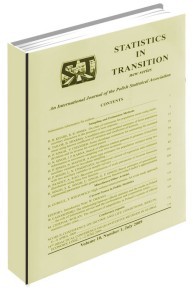Covariate Selection for Small Area Estimation in Repeated Sample Surveys
Covariate Selection for Small Area Estimation in Repeated Sample Surveys
Author(s): Jan A. van den Brakel, Bart BuelensSubject(s): Economy
Published by: Główny Urząd Statystyczny
Keywords: area level models; cAIC; Hierachical Bayesian predictors
Summary/Abstract: If the implementation of small area estimation methods to multiple editions of a repeated sample survey is considered, then the question arises which covariates to use in the models. Applying standard model selection procedures independently to the different editions of the survey may identify different sets of covariates for each edition. If the small area predictions are sensitive to the different models, this is undesirable in official statistics since monitoring change over time of statistical quantities is of utmost importance. Therefore, potential confounding of true change and methodological alterations should be avoided. An approach to model selection is proposed resulting in a single set of covariates for multiple survey editions. This is achieved through conducting covariate selection simultaneously for all editions, minimizing the average of the edition-specific conditional Akaike Information Criteria. Consecutive editions of the Dutch crime victimization survey are used as a case study. Municipal estimates of three survey variables are obtained using area level models. The proposed averaging strategy is compared to the standard method of considering each edition separately, and to an elementary approach using covariates selected in the first edition. Resulting models, point estimates and MSE estimates are analyzed, indicating no substantial adverse effects of the conceptually attractive averaging strategy.
Journal: Statistics in Transition. New Series
- Issue Year: 16/2015
- Issue No: 4
- Page Range: 523-540
- Page Count: 18
- Language: English

